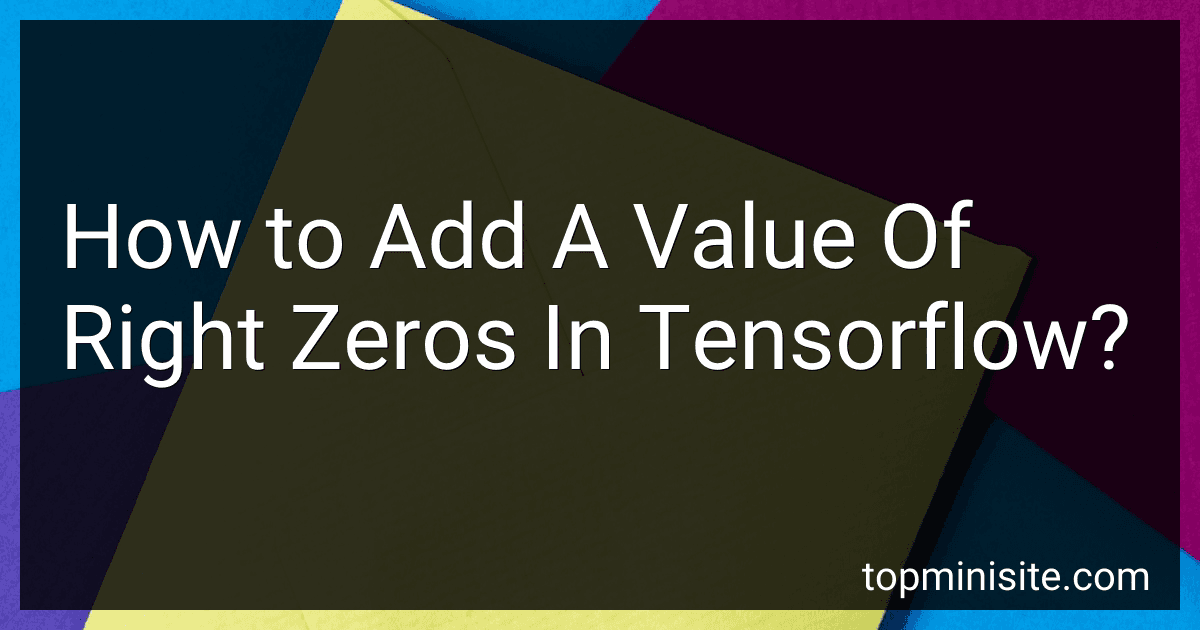Posts (page 99)
-
 4 min readIn TensorFlow, you can save the progress of your model after the first epoch by using the ModelCheckpoint callback. This callback allows you to save the model at specific points during training, such as after each epoch.To use the ModelCheckpoint callback, you need to create an instance of the callback and specify the filename for the checkpoint to be saved. You can also specify other options such as monitoring a specific metric and saving only the best model based on that metric.
4 min readIn TensorFlow, you can save the progress of your model after the first epoch by using the ModelCheckpoint callback. This callback allows you to save the model at specific points during training, such as after each epoch.To use the ModelCheckpoint callback, you need to create an instance of the callback and specify the filename for the checkpoint to be saved. You can also specify other options such as monitoring a specific metric and saving only the best model based on that metric.
-
 3 min readTo put multidimensional array input in TensorFlow, you can use the tf.data.Dataset API to create a dataset from your array. You can convert your array into a TensorFlow Tensor using tf.convert_to_tensor() and then create a dataset using tf.data.Dataset.from_tensor_slices(). You can also use the batch() method to create batches of your input data. Additionally, you can specify the number of epochs and shuffling of your dataset using the appropriate methods provided by the tf.data.Dataset API.
3 min readTo put multidimensional array input in TensorFlow, you can use the tf.data.Dataset API to create a dataset from your array. You can convert your array into a TensorFlow Tensor using tf.convert_to_tensor() and then create a dataset using tf.data.Dataset.from_tensor_slices(). You can also use the batch() method to create batches of your input data. Additionally, you can specify the number of epochs and shuffling of your dataset using the appropriate methods provided by the tf.data.Dataset API.
-
 4 min readTo load a trained model and continue training in TensorFlow, the process typically involves loading the saved model using the tf.keras.models.load_model() function, restoring the model's weights, compiling the model with the desired optimizer and loss function, and then training the model using new data. This allows you to pick up training from where you left off or fine-tune a pre-trained model for a specific task.
4 min readTo load a trained model and continue training in TensorFlow, the process typically involves loading the saved model using the tf.keras.models.load_model() function, restoring the model's weights, compiling the model with the desired optimizer and loss function, and then training the model using new data. This allows you to pick up training from where you left off or fine-tune a pre-trained model for a specific task.
-
 3 min readTo get the class names in a TensorFlow dataset, you can use the class_names attribute of the dataset object. This attribute will return a list of all the unique class names present in the dataset. You can then use this list for various purposes such as creating a mapping of class names to class indices, visualizing the distribution of classes in the dataset, or any other analysis that requires access to the class names.
3 min readTo get the class names in a TensorFlow dataset, you can use the class_names attribute of the dataset object. This attribute will return a list of all the unique class names present in the dataset. You can then use this list for various purposes such as creating a mapping of class names to class indices, visualizing the distribution of classes in the dataset, or any other analysis that requires access to the class names.
-
 3 min readTo get a summary of a TensorFlow model, you can use the model.summary() method. This will display a concise summary of your model, including the layer names, the shape of the input and output tensors for each layer, and the number of parameters in each layer. This summary can help you quickly understand the structure of your model and ensure everything is set up correctly before training.
3 min readTo get a summary of a TensorFlow model, you can use the model.summary() method. This will display a concise summary of your model, including the layer names, the shape of the input and output tensors for each layer, and the number of parameters in each layer. This summary can help you quickly understand the structure of your model and ensure everything is set up correctly before training.
-
 5 min readTo convert a string to a TensorFlow model, you can use TensorFlow's text preprocessing tools such as Tokenizer or TextVectorization to convert the string into a format suitable for input into a neural network model. You can then use TensorFlow's layers API to build a neural network model that can process the input data represented by the string. Once the model is trained and saved, you can then use TensorFlow's functions to load the model and make predictions on new input strings.
5 min readTo convert a string to a TensorFlow model, you can use TensorFlow's text preprocessing tools such as Tokenizer or TextVectorization to convert the string into a format suitable for input into a neural network model. You can then use TensorFlow's layers API to build a neural network model that can process the input data represented by the string. Once the model is trained and saved, you can then use TensorFlow's functions to load the model and make predictions on new input strings.
-
 3 min readTo save Keras models without TensorFlow, you can use the built-in methods provided by Keras itself. You can save the model architecture to a JSON file using the to_json method and save the model weights to an HDF5 file using the save_weights method. By saving the model architecture and weights separately, you can easily recreate and load the model later using the model_from_json and load_weights methods. This way, you can save and load Keras models without relying on TensorFlow-specific APIs.
3 min readTo save Keras models without TensorFlow, you can use the built-in methods provided by Keras itself. You can save the model architecture to a JSON file using the to_json method and save the model weights to an HDF5 file using the save_weights method. By saving the model architecture and weights separately, you can easily recreate and load the model later using the model_from_json and load_weights methods. This way, you can save and load Keras models without relying on TensorFlow-specific APIs.
-
 5 min readIn TensorFlow, you can add a desired number of zeros to the right side of a tensor by using the tf.pad function. This function allows you to specify the number of zeros to be added on each side of the tensor for each dimension. You can achieve this by creating a padding tensor that has the desired number of zeros and then using tf.pad to concatenate it to the original tensor. This can be useful when you need to adjust the dimensions of a tensor or prepare it for further processing.
5 min readIn TensorFlow, you can add a desired number of zeros to the right side of a tensor by using the tf.pad function. This function allows you to specify the number of zeros to be added on each side of the tensor for each dimension. You can achieve this by creating a padding tensor that has the desired number of zeros and then using tf.pad to concatenate it to the original tensor. This can be useful when you need to adjust the dimensions of a tensor or prepare it for further processing.
-
 5 min readTo remove a specific neuron inside a TensorFlow Keras model, you can do so by modifying the weights of the layer containing the neuron you want to remove. You can set the weights of the neuron to zero or remove the connections of the neuron within the layer. You can access the weights of a layer using the get_weights() and set_weights() functions of the layer object. By setting the weights of the neuron to zero, you effectively remove its influence on the output of the model.
5 min readTo remove a specific neuron inside a TensorFlow Keras model, you can do so by modifying the weights of the layer containing the neuron you want to remove. You can set the weights of the neuron to zero or remove the connections of the neuron within the layer. You can access the weights of a layer using the get_weights() and set_weights() functions of the layer object. By setting the weights of the neuron to zero, you effectively remove its influence on the output of the model.
-
 3 min readTo write a circulant matrix in TensorFlow, you can use the tf.signal.fft2d function to compute the 2D Fourier transform of a given vector. By reshaping the input vector into a 2D matrix and applying the fft2d function, you can obtain the circulant matrix corresponding to the input vector. This circulant matrix can then be used for various linear algebra operations in TensorFlow.[rating:c6bb61eb-f6e1-44cf-8a8b-45bc7076eacc]How to compress a circulant matrix in TensorFlow.
3 min readTo write a circulant matrix in TensorFlow, you can use the tf.signal.fft2d function to compute the 2D Fourier transform of a given vector. By reshaping the input vector into a 2D matrix and applying the fft2d function, you can obtain the circulant matrix corresponding to the input vector. This circulant matrix can then be used for various linear algebra operations in TensorFlow.[rating:c6bb61eb-f6e1-44cf-8a8b-45bc7076eacc]How to compress a circulant matrix in TensorFlow.
-
 4 min readTensor cores are specialized hardware units found in modern GPUs that are designed to accelerate matrix operations, particularly those used in deep learning and machine learning applications. They can greatly increase the speed of training neural networks and performing tensor computations.In PyTorch and TensorFlow, developers can take advantage of tensor cores by using specific libraries or functions that are optimized to utilize this hardware. For example, PyTorch provides the torch.nn.
4 min readTensor cores are specialized hardware units found in modern GPUs that are designed to accelerate matrix operations, particularly those used in deep learning and machine learning applications. They can greatly increase the speed of training neural networks and performing tensor computations.In PyTorch and TensorFlow, developers can take advantage of tensor cores by using specific libraries or functions that are optimized to utilize this hardware. For example, PyTorch provides the torch.nn.
-
 5 min readIn TensorFlow, if you have a model that contains non-serializable objects, such as custom layers or custom metrics that cannot be directly serialized using the built-in methods, you can still save the model by implementing a custom saving method.One approach is to use the tf.keras.callbacks.ModelCheckpoint callback during training to save the model weights at regular intervals. This way, you can restore the model from the saved weights without needing to serialize the entire model.
5 min readIn TensorFlow, if you have a model that contains non-serializable objects, such as custom layers or custom metrics that cannot be directly serialized using the built-in methods, you can still save the model by implementing a custom saving method.One approach is to use the tf.keras.callbacks.ModelCheckpoint callback during training to save the model weights at regular intervals. This way, you can restore the model from the saved weights without needing to serialize the entire model.